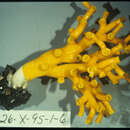Comprehensive Description
(
Inglês
)
fornecido por Smithsonian Contributions to Zoology
Dendrophyllia oldroydae Oldroyd 1924, nom. correct
Dendrophyllia oldroydi Oldroyd, 1924, pl. 49: fig. 7.—Williams, 1936:27–28, 1 fig.
Dendrophyllia oldroydi Faustino, 1931:286–287, pl. 1: fig. 2.—?Durham, 1943:201, pl. 32: fig. 1; 1947:38, pl. 10: figs. 1, 9.—Bythell, 1986:21, pl. 12: figs. a-d.—Prahl, 1987:230, figs. 6, 7.—Prahl and Erhardt, 1989:549–550, fig. 9.—Cairns et al., 1991:48.
Dendrophyllia californica.—Durham and Barnard, 1952:101 [in part: pl. 15: fig. 65a,b].—Cairns, 1991a:23–24, pl. 10: figs. c-e.
Dendrophyllia cortezi Durham and Barnard, 1952:102–103, pl. 16: fig. 66a,b—Squires, 1959:426.
Dendrophyllia cf. D, oldroydi Faustino.—Hertlein and Grant, 1960:82–83, pl. 19: figs. 5, 6, 15.
DESCRIPTION.—Corallum sympodially branched, forming large bushy colonies up to 1 m in height (Cairns, 1991a) and having robust basal branches up to 5 cm in diameter; largest colonies examined from off California only 35 cm in height with a basal branch diameter of 2.2 cm. Corallites short and stout on large-diameter basal branches, projecting only 4–7 mm perpendicular to main branch (e.g., Durham and Barnard, 1952, pl. 15: fig. 65a), but distal corallites, especially those of fast growing coralla, are inclined distally and elongate, up to 23 mm long (e.g., Williams, 1936, fig. 1). Calices elliptical and usually less than 10 mm in GCD, but may reach up to 15 × 13 mm in GCD × LCD (USNM 80453). Costae equal in width and slightly convex, separated by narrow intercostal striae and covered with small (0.10 mm diameter) granules. However, within 5–7 mm of the calice, intercostal striae are often perforate, and C1–2 in this region are slightly narrower than the others and slightly ridged. Corallum white; coenosarc yellow, drying to a dark brown.
Septa hexamerally arranged in 5 cycles, the last cycle always incomplete. Each half-system usually contains either no S5, sometimes 1 pair of S5, or rarely 2 pairs of S5, for a total of only 48 septa if no S5 are present, and up to 72 if 12 pairs of S5 are present, as in the case of the largest calice. Most corallites have 48–58 septa (0–6 pairs of S5). S1–2 equal in size, only about 1.5 mm exsert, relatively narrow (only about 1.5 mm wide), and have straight inner edges that attain the columella. S3 little exsert and are the smallest septa, only about 0.5 mm wide and merging into the paliform lobe formed by flanking S4. S4 paired and equal in exsertness to S3, but about 1.2 mm in width, the inner edges of each pair solidly fused before its adjacent S3 to form a tall, rounded paliform lobe, which is thicker than an S3 and of equal width to an S4. In most corallites these 12 P3 form a crown of lobes, but in larger corallites having pairs of S5, 2 P4 are formed in each half-system instead of 1 P3. Inner edges of paliform lobes reach columella and appear to be continuous with columellar structure. Fossa shallow, containing a columella of variable size and structure. Columella usually composed of an elongate to elliptical mass of swirled elements, sometimes appearing fascicular, other times as coarsely papillose. Columella width varies from rudimentary, only 12% LCD, to quite large (Plate 12j), up to 37% LCD. All septal faces, paliform lobes, and columellar elements covered with a fine granulation.
- citação bibliográfica
- Cairns, Stephen D. 1994. "Scleractinia of the temperate North Pacific." Smithsonian Contributions to Zoology. i-150. https://doi.org/10.5479/si.00810282.557.i
Biology
(
Inglês
)
fornecido por World Register of Marine Species
azooxanthellate
van der Land, J. (ed). (2008). UNESCO-IOC Register of Marine Organisms (URMO).
- licença
- cc-by-4.0
- direitos autorais
- WoRMS Editorial Board
Depth range
(
Inglês
)
fornecido por World Register of Marine Species
40-576 m
- licença
- cc-by-4.0
- direitos autorais
- WoRMS Editorial Board

